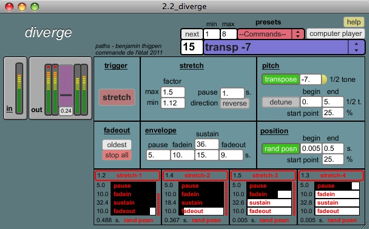|
|
“There will come a time,” he continued, “probably in the near future, when you will look at yourselves and think, ‘where am I, and where am I going?’ The answer is this: you are at a crossroads, and you must choose your path. Where you go, my kits, depends solely on you. Remember that, and choose wisely.”
– Camille Thigpen |
|
|
|
paths is a suite of seven brief pieces for acoustic instrument(s) and computer. They may be performed using any instrument or sounding body, traditional or experimental, and using any playing techniques – classical, extended, virtuosic, elementary. The pieces may be played individually or together, in any order or configuration. If several pieces are grouped together, they need not be performed by the same instrument or musician. Any possible combination of the pieces performed on any instrument or combination of instruments constitutes a valid interpretation of paths.
There is no traditionally notated score. Instead, there are written and graphic instructions for how the piece is to be realized and interpreted. Each piece consists of these indications accompanied by a computer program written in Max/MSP – the computer part, over which the musician has varying degrees of control. To prepare a piece, the musician needs to study the score and experiment with the computer program. He must then choose a strategy (a “path”) and practice until he is comfortable with the piece and satisfied with the result.
Rather than a stable, fixed aesthetic object, paths is a collection of actions, activities, processes, procedures – a framework for the realization of an unlimited number of unique pieces. What is demanded of the musician is not so much to execute a score correctly as to have an active, creative input – essentially, to collaborate in the creation of an original piece of music. The point is not to arrive at a particular destination but to choose, define and follow a path.
It is impossible to play a “wrong note” in paths. In that sense, the musician is free to play “anything he wants.” At the same time, however, he must accept responsibility for the overall effect and impact of the piece – the music itself – which may be more difficult than following instructions...
All the sounds generated by the computer originate with the instrument, and yet the musician can only partially control how the computer manipulates them. Most of the computer processes involve an important element of variability: they will not produce exactly the same result twice. Thus the musician remains in a position of interactivity: he must continually listen to the computer and play in relation to it. To perform paths, one must not only actively determine how the music should be structured (“choose your path”), but also adapt to the changes and variations and unforeseen phenomena that occur while performing the piece in concert.
Comissioned by the French Ministry of Culture 2011. |
|
